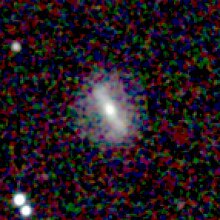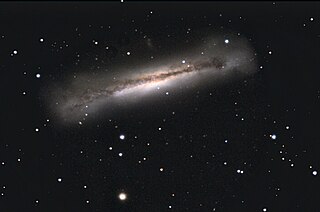
NGC 3628, also known as the Hamburger Galaxy or Sarah's Galaxy, is an unbarred spiral galaxy about 35 million light-years away in the constellation Leo. It was discovered by William Herschel in 1784. It has an approximately 300,000 light-years long tidal tail. Along with M65 and M66, NGC 3628 forms the Leo Triplet, a small group of galaxies. Its most conspicuous feature is the broad and obscuring band of dust located along the outer edge of its spiral arms, effectively transecting the galaxy to the view from Earth.

NGC 659 is an open cluster in the Cassiopeia constellation. It was discovered by Caroline Herschel in 1783.
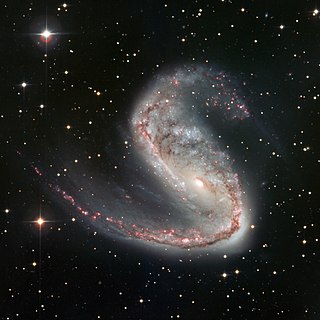
NGC 2442 and NGC 2443 are two parts of a single intermediate spiral galaxy, commonly known as the Meathook Galaxy or the Cobra and Mouse. It is about 50 million light-years away in the constellation Volans. It was discovered by Sir John Herschel on December 23, 1834 during his survey of southern skies with a 18.25 inch diameter reflecting telescope from an observatory he set up in Cape Town, South Africa. Associated with this galaxy is HIPASS J0731-69, a cloud of gas devoid of any stars. It is likely that the cloud was torn loose from NGC 2442 by a companion.
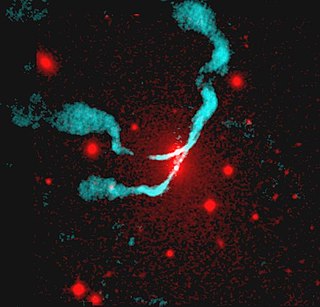
NGC 1128 is a dumbbell galaxy in the Abell 400 galaxy cluster. At the center of the galaxy is 3C 75, a radio source, and contains two orbiting supermassive black holes that may be merging. Computer simulations indicate that these two black holes will gradually spiral in toward each other until they merge. Lewis Swift is credited with the discovery of NGC 1128 in 1886.

NGC 1234 is a peculiar barred spiral galaxy exhibiting a ring structure in the constellation Eridanus, discovered by Francis Preserved Leavenworth in 1886.

NGC 559 is an open cluster and Caldwell object in the constellation Cassiopeia. It shines at magnitude +9.5. Its celestial coordinates are RA 01h 29.5m, dec +63° 18′. It is located near the open cluster NGC 637, and the bright magnitude +2.2 irregular variable star Gamma Cassiopeiae. The cluster is 7 arcmins across.

NGC 7008, also known as the Fetus Nebula is a planetary nebula with a diameter of approximately 1 light-year located at a distance of 2800 light years in northern Cygnus. It was discovered by William Herschel in 1787, in Slough, England. NGC 7008 is included in the Astronomical League's Herschel 400 observing program.
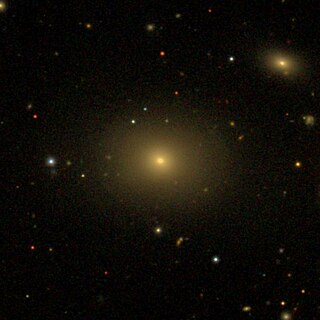
NGC 3357 is an elliptical galaxy located in the constellation of Leo. It was discovered on April 5, 1864 by German astronomer Albert Marth.

NGC 1579 is a diffuse nebula located in the constellation of Perseus. It is referred to as the Northern Trifid because of its similar appearance to the Trifid Nebula, which is located in the southern celestial hemisphere of the sky. It is a H II region, a region of star formation.

NGC 2082 is an intermediate spiral galaxy in the Dorado constellation. It was originally thought to be part of the Dorado Group of galaxies, but was later removed. It was discovered on November 30, 1834 by John Herschel.

NGC 70 is a spiral galaxy located in the constellation Andromeda. It was discovered on October 7, 1855, by R. J. Mitchell and was also observed on December 19, 1897 by Guillaume Bigourdan from France who described it as "extremely faint, very small, round, between 2 faint stars".

NGC 71 is an elliptical galaxy located in the constellation Andromeda. It is in the NGC 68 group. The galaxy was discovered by R. J. Mitchell in 1855, and observed in 1865 by Heinrich d'Arrest, who described it as "extremely faint, very small, round". The galaxy is about 110,000-130,000 light years across, making it just slightly larger than the Milky Way. The galaxy is the second largest in the NGC 68 group, after spiral galaxy NGC 70.

NGC 72 is a barred spiral galaxy estimated to be about 320 million light-years away in the constellation of Andromeda. It was discovered by R. J. Mitchell in 1855 and its magnitude is 13.5.

NGC 114 is a barred lenticular galaxy located in the constellation Cetus. It was discovered by American astronomer Truman Henry Safford on September 23, 1867. The galaxy lies approximately 195 million light-years from Earth, and is about 55,000 light-years in diameter, nearly half the size of the Milky Way.
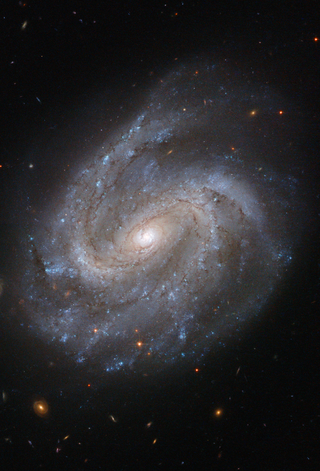
NGC 201 is a spiral galaxy in the constellation of Cetus. It is one of the group members of HCG 7, with the other group members NGC 192, NGC 196, and NGC 197. It was discovered on December 28, 1790 by William Herschel.

NGC 6373 is a barred spiral galaxy located in the constellation Draco. It is designated as SBc in the galaxy morphological classification scheme and was discovered by the American astronomer Lewis A. Swift on 13 June 1885. There are two recorded supernovae in this galaxy designated SN 2001ad and SN 2012an.
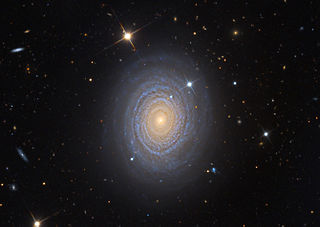
NGC 488 is a face-on spiral galaxy in the constellation Pisces. It is at a distance of about 90 million light-years away from Earth. Its diameter is estimated to be 52,6 Kpc. The galaxy has a large central bulge, and is considered a prototype galaxy with multiple spiral arms. Its arms are tightly wound. Star forming activity has been traced within the arms. The nucleus of NGC 488 has been found to be chemically decoupled, being twice as metal rich as the central bulge of the galaxy. NGC 488, with the exception of its smaller companions, that form NGC 488 group, is an isolated galaxy.

NGC 4473 is an elliptical galaxy located about 50 million light-years away in the constellation of Coma Berenices. It was discovered by astronomer William Herschel on April 8, 1784. NGC 4473 has an inclination of about 71°. NGC 4473 is a member of a chain of galaxies called Markarian's Chain which is part of the larger Virgo Cluster of galaxies.

NGC 938 is an elliptical galaxy located in the constellation Aries, approximately 184 million light years from the Milky Way. It was discovered by the Prussian astronomer Heinrich d'Arrest in 1863.
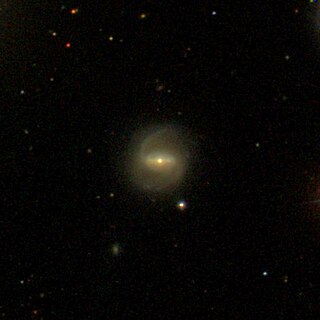
NGC 4333 is a barred spiral galaxy with a ring structure located about 330 million light-years away in the constellation Virgo. It was discovered by astronomer William Herschel on April 13, 1784, who described it as "F, pS, R, bM, 2nd of 3". NGC 4333 is also classified as a LINER galaxy. Despite being listed in the Virgo Cluster catalog as VCC 637, it is not a member of the Virgo Cluster but instead a background galaxy.
